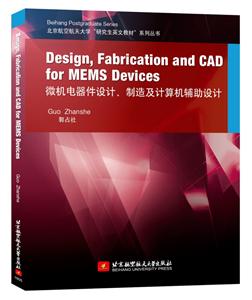-
>
闖進數學世界――探秘歷史名題
-
>
中醫基礎理論
-
>
當代中國政府與政治(新編21世紀公共管理系列教材)
-
>
高校軍事課教程
-
>
思想道德與法治(2021年版)
-
>
毛澤東思想和中國特色社會主義理論體系概論(2021年版)
-
>
中醫內科學·全國中醫藥行業高等教育“十四五”規劃教材
微機電器件設計.制造及計算機輔助設計 版權信息
- ISBN:9787512421097
- 條形碼:9787512421097 ; 978-7-5124-2109-7
- 裝幀:暫無
- 冊數:暫無
- 重量:暫無
- 所屬分類:>>
微機電器件設計.制造及計算機輔助設計 內容簡介
Thisbookfirstlyintroducesthepertinentfundamentaltheory,importantmaterialandfabricationprocessofmicroGelectromechanicalsystems.Basedonthesetheories,thedesignruleandimportantengineeringexamplesaredescribedindetail.Then,manyengineeringapplicationsforMEMSincludingtheaccelerationmeasurement,theangularspeedmeasurementandthepressuremeasurementareintroduced.Finally,finiteelementmethodisintroducedinordertoprovethecorrectnessofthedesign.Thisengineeringapplicationofsimulationincludesthestaticandmodalanalysisofthebeam,capacitanceanalysis,thermalGstructureanalysisofthedeviceandfatigueanalysisetc.Itcanbeselectedasthereferencetothepostgraduates,undergraduatesandpertinentengineeringstaffwhoseresearch directionsareinstrumentationscienceandtechnology,controlscienceandengineering,mechanicalengineeringetc.
微機電器件設計.制造及計算機輔助設計 目錄
1.1 ConceptofMEMS ……………………………………………………………………… 1
1.2 DevelopmentofMEMS ………………………………………………………………… 4
1.3 MEMSCAD …………………………………………………………………………… 9
Chapter2 BasictheoryofMEMS …………………………………………………………… 12
2.1 TheoryofelectrostaticMEMScombactuators …………………………………… 12
2.1.1 Introduction ……………………………………………………………………… 12
2.1.2 Operatingprinciples …………………………………………………………… 13
2.1.3 Platecapacitortheoryinidealcondition ……………………………………… 14
2.1.4 ThemodifiedmodelofMEMSplatecapaciator ……………………………… 17
2.1.5 Calculationofelectrostaticcombdrivingforceinidealsituation …………… 24
2.1.6 Weakcapacitancedetectionmethodofelectrostaticcombdrive …………… 26
2.2 RelevanttheoreticalcalculationsfortheMEMScantileverbeam ………………… 34
2.2.1 Introduction ……………………………………………………………………… 34
2.2.2 Theoreticalcalculationmethodforcantileverbeam ………………………… 35
2.2.3 RelevanttheoreticalcalculationofaxialtensileandcompressiveonsingleGend
clampedbeams ………………………………………………………………… 36
2.2.4 RelatedtheoreticalcalculationsofdoubleGendclampedbeamsaxialtension
andcompression ………………………………………………………………… 40
2.3 MembranetheoryofMEMS ………………………………………………………… 47
2.3.1 Theoryofclampedaroundcirculardiaphragm ………………………………… 48
2.3.2 Theoryofclampedaroundrectangularflatdiaphragm ……………………… 49
References …………………………………………………………………………………… 52
Chapter3 MEMSmaterials …………………………………………………………………… 53
3.1 Monocrystallinesilicon ……………………………………………………………… 53
3.1.1 Introduction ……………………………………………………………………… 53
3.1.2 Crystalorientationofmonocrystallinesilicon ………………………………… 55
3.2 Polycrystallinesilicon ………………………………………………………………… 64
3.3 Silica …………………………………………………………………………………… 66
3.4 Piezoelectricmaterials ………………………………………………………………… 67
3.4.1 Piezoelectriceffectandinversepiezoelectriceffectofmaterials …………… 67
3.4.2 Quartzcrystal …………………………………………………………………… 68
3.4.3 Piezoelectricceramics …………………………………………………………… 73
3.5 OtherMEMSmaterials ……………………………………………………………… 75
3.6 Summary ……………………………………………………………………………… 76
Chapter4 MEMStechnology ………………………………………………………………… 77
4.1 MEMSlithographyprocess ………………………………………………………… 78
4.2 KeytechnologyofMEMSlithographyprocess …………………………………… 80
4.2.1 Wafercleaning …………………………………………………………………… 80
4.2.2 Siliconoxidation ………………………………………………………………… 80
4.2.3 Spincoatingprocess …………………………………………………………… 87
4.2.4 Prebaking ………………………………………………………………………… 90
4.2.5 Exposure ………………………………………………………………………… 92
4.2.6 Development ……………………………………………………………………… 94
4.2.7 Hardening ………………………………………………………………………… 96
4.2.8 FabricationoftheSiO2 window ………………………………………………… 97
4.3 SubsequentprocessofMEMS ……………………………………………………… 98
4.3.1 Bulksilicontechnology ………………………………………………………… 98
4.3.2 Surfacesiliconprocess ………………………………………………………… 103
4.3.3 LIGAtechnology ……………………………………………………………… 104
4.3.4 Sputteringtechnology ………………………………………………………… 105
4.3.5 LiftGoffprocess ………………………………………………………………… 107
4.4 Filmpreparationtechnology………………………………………………………… 107
4.5 Bondingprocess ……………………………………………………………………… 108
4.5.1 Anodicbondingprocess………………………………………………………… 109
4.5.2 SiliconGsilicondirectbonding ………………………………………………… 110
4.5.3 Metaleutecticbonding ………………………………………………………… 113
4.5.4 Coldpressureweldingbonding ……………………………………………… 114
4.6 Engineeringexamplesofcombinationformultipleprocessestofabricatethe
MEMSdevice ………………………………………………………………………… 115
4.6.1 Introduction …………………………………………………………………… 115
4.6.2 EngineeringexampleoffabricationprocessforresonantMEMSgyroscope
…………………………………………………………………………………… 115
4.6.3 EngineeringexampleofelectromagneticmicroGmotorproductionprocess
…………………………………………………………………………………… 118
4.7 Summary ……………………………………………………………………………… 124
References…………………………………………………………………………………… 125
Chapter5 Frictionwearandtearundermicroscale ……………………………………… 126
5.1 OffGchiptestingmethodformicrofriction ………………………………………… 127
5.1.1 MicroGtribologytestwiththepinGonGdiscmeasuringmethod ……………… 127
5.1.2 MicroGtribologytestwithAFM ……………………………………………… 128
5.1.3 MicroGtribologytestwithspecialmeasuringdevice ………………………… 130
5.2 OnGchiptestingmethodformicrofriction ………………………………………… 132
5.2.1 OnGchiptestingmethodactuatedbyelectrostaticforce …………………… 132
5.2.2 OnGchipmicroGfrictiontestingmethodusingthemechanismcharactersof
thebimorphmaterial…………………………………………………………… 139
5.3 ExampleofthedesignforanonGchipmicroGfrictionstructure ………………… 141
5.3.1 Structureandworkingprinciple ……………………………………………… 141
5.3.2 Calculationofpertinenttheory ……………………………………………… 142
5.3.3 Technologicalanalysisofstructuraldesign ………………………………… 148
5.3.4 Testingresultsanddataanalysis……………………………………………… 152
5.3.5 ResearchandtestofwearproblemofMEMSdevices ……………………… 161
5.4 Summary ……………………………………………………………………………… 165
References…………………………………………………………………………………… 165
Chapter6 MEMStestingtechnologyandengineeringapplication ………………………… 169
6.1 Accelerationmeasurementandcorrespondingsensors …………………………… 169
6.1.1 Workingprincipleoftheaccelerationsensorandtheclassification ……… 170
6.1.2 Capacitivesiliconmicromechanicalaccelerometer …………………………… 172
6.1.3 Piezoresistivesiliconmicromechanicalaccelerometer ……………………… 173
6.1.4 Piezoelectricmicromechanicalaccelerometer ………………………………… 174
6.1.5 ResonantsiliconMEMSaccelerometer ……………………………………… 175
6.2 Angularspeedmeasurementandcorrespondingsensors ………………………… 177
6.2.1 Workingprinciple ……………………………………………………………… 177
6.2.2 DevelopmentofMEMSgyroscope …………………………………………… 178
6.2.3 Classificationofmicromechanicalgyroscope ………………………………… 188
6.3 Pressuremeasurementandcorrespondingsensors ……………………………… 190
6.3.1 Workingpincinple ……………………………………………………………… 190
6.3.2 Resonantsiliconmicromechanicalpressuresensoranditsdevelopment … 193
6.4 MeasurementofmicroGtorque ……………………………………………………… 198
6.4.1 Introduction …………………………………………………………………… 198
6.4.2 Workingprincipleofnoncontactmethod …………………………………… 199
6.4.3 Theoreticalcalculation ………………………………………………………… 200
6.4.4 Correspondingequipmenttorealizethenoncontactmethod ……………… 205
6.4.5 Experimentresultanddiscussion …………………………………………… 209
6.5 Microscopicmorphologytestingmethod ………………………………………… 211
6.6 Summary ……………………………………………………………………………… 212
References…………………………………………………………………………………… 212
Chapter7 Applicationexamplesofthefiniteelementmethodinthedesignof
MEMSdevices …………………………………………………………………… 218
7.1 Importantconceptsofthesoftware………………………………………………… 218
7.2 IntroductionoftheAnsyssoftwareinterface……………………………………… 220
7.3 ThecoordinatesysteminAnsys …………………………………………………… 221
7.4 Engineeringexamples ……………………………………………………………… 226
7.4.1 StaticanalysisofsingleGclampedbeam ……………………………………… 226
7.4.2 ModalanalysisofdoubleGclampedbeam ……………………………………… 245
7.4.3 CapacitanceanalysisofMEMSelectrostaticcombfingersdrive …………… 257
7.4.4 Fatiguestrengthcalculationexample ………………………………………… 264
7.5 Summary ……………………………………………………………………………… 272
- >
月亮虎
- >
上帝之肋:男人的真實旅程
- >
莉莉和章魚
- >
史學評論
- >
詩經-先民的歌唱
- >
羅曼·羅蘭讀書隨筆-精裝
- >
大紅狗在馬戲團-大紅狗克里弗-助人
- >
名家帶你讀魯迅:故事新編

















